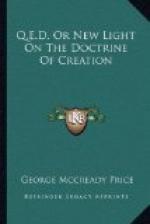The wisest of the ancients in Greece and Rome knew nothing of this great law as we now know it. Aristotle, the embodiment of all that the ancient world knew of natural science, expressly taught that the lower forms of animals, such as fleas and worms, even mice and frogs, sprang up spontaneously from the moist earth. “All dry bodies,” he declared, “which become damp, and all damp bodies which are dried, engender animal life.” According to Vergil, bees are produced from the putrifying entrails of a young bull. Such were the teachings of all the Greeks and Romans, even of the scientists of the post-Reformation period, some of whom had accumulated a very considerable stock of knowledge concerning plants and animals.
And similar absurdities continued to be taught until comparatively modern times. Van Helmont, a celebrated alchemist physician who flourished during the brilliant reign of Louis XIV, wrote: “The smells which arise from the bottom of morasses produce frogs, slugs, leeches, grasses, and other things.” As a recipe for producing a pot of mice offhand, he says that the only thing necessary is partly to fill a vessel with corn and plug up the mouth of the vessel with an old dirty shirt. In about twenty-one days, the ferment arising from the dirty shirt reacting with the odor from the corn will effect the transmutation of the wheat into mice. The doctor solemnly assures us that he himself had witnessed this wonderful fact, and continues, “The mice are born full-grown; there are both males and females. To reproduce the species it suffices to pair them.”
“Scoop out a hole in a brick,” he says further, “put into it some sweet basil, crushed, lay a second brick upon the first so that the hole may be completely covered. Expose the two bricks to the sun, and at the end of a few days the smell of the sweet basil, acting as a ferment, will change the herb into real scorpions."[7]
[Footnote 7: “Louis Pasteur, His Life and Labors,” p. 89.]
Sir Thomas Browne, the famous author of “Religio Medici,” had expressed a doubt as to whether mice may be bred by putrifaction; but another scientist, Alexander Ross, disposed of this suggestion by the following line of argument which was supposed to be conclusive as a reductio ad absurdum:
“So may he (Sir Thomas Browne) doubt whether in cheese and timber worms are generated; or if beetles and wasps in cows’ dung; or if butterflies, locusts, grasshoppers, shell-fish, snails, eels, and such like, be procreated of putrid matter, which is apt to receive the form of that creature to which it is by formative power disposed. To question this is to question reason, sense and experience. If he doubts this let him go to Egypt, and there he will find the fields swarming with mice, begot of the mud of Nylus, to the great calamity of the in-habitants."[8]
[Footnote 8: Encyclopaedia Britannica, Vol. I, p. 64.]
When we remember that such nonsense constituted the wisdom of the scientific world only about two centuries ago, we begin to realize the fact that the doctrine of Biogenesis is indeed a very modern doctrine. But it may be well to ask in passing, How could the people of former ages understand or appreciate the great truth of Creation as we moderns are able to do?




